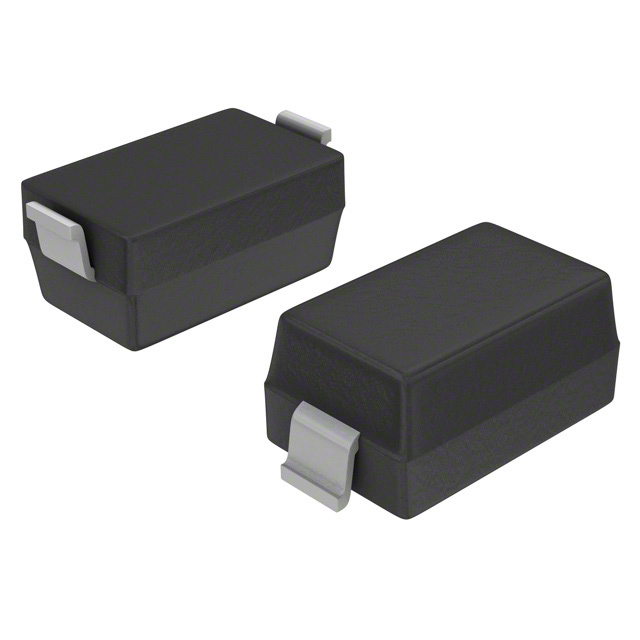BZT52C47-7: Product Overview and Detailed Information
Introduction
The BZT52C47-7 is a diode belonging to the category of Zener diodes. It is commonly used in electronic circuits for voltage regulation and protection against voltage spikes. This entry provides an overview of the basic information, specifications, pin configuration, functional features, advantages and disadvantages, working principles, application field plans, and alternative models of the BZT52C47-7.
Basic Information Overview
- Category: Zener Diode
- Use: Voltage regulation, voltage spike protection
- Characteristics: Low leakage current, precise voltage regulation
- Package: SOD-123 package
- Essence: Semiconductor diode
- Packaging/Quantity: Typically available in reels or tubes containing multiple units
Specifications
- Voltage: 47V
- Power Dissipation: 350mW
- Operating Temperature Range: -65°C to +150°C
- Forward Voltage: 1V
- Reverse Current: 5μA
Detailed Pin Configuration
The BZT52C47-7 Zener diode has two pins, with the cathode marked by a band on the body of the diode. The pinout configuration is as follows: - Pin 1 (Anode) - Pin 2 (Cathode)
Functional Features
- Precise voltage regulation at 47V
- Low reverse leakage current
- Fast response time to voltage variations
- Compact SOD-123 package for space-constrained applications
Advantages and Disadvantages
Advantages
- Accurate voltage regulation
- Small form factor
- Low reverse leakage current
Disadvantages
- Limited power dissipation capability
- Sensitive to temperature variations
Working Principles
The BZT52C47-7 operates based on the Zener effect, where it maintains a constant voltage drop across its terminals when it is reverse-biased. This allows it to regulate the voltage in a circuit, providing stability and protection against voltage surges.
Detailed Application Field Plans
The BZT52C47-7 finds extensive use in various electronic applications, including: - Voltage regulators in power supplies - Overvoltage protection circuits - Signal clamping and limiting circuits - Voltage reference sources
Detailed and Complete Alternative Models
Some alternative models to the BZT52C47-7 include: - BZT52C3V6-7 (3.6V Zener diode) - BZT52C15-7 (15V Zener diode) - BZT52C33-7 (33V Zener diode) - BZT52C56-7 (56V Zener diode)
In conclusion, the BZT52C47-7 Zener diode offers precise voltage regulation and protection in a compact package, making it suitable for a wide range of electronic applications.
(Word count: 413)
Lista 10 Vanliga frågor och svar relaterade till tillämpningen av BZT52C47-7 i tekniska lösningar
What is the BZT52C47-7?
- The BZT52C47-7 is a 47V Zener diode designed for voltage regulation and protection in various electronic circuits.
What are the typical applications of BZT52C47-7?
- It is commonly used for voltage regulation, overvoltage protection, and as a reference voltage source in electronic circuits.
What is the maximum power dissipation of BZT52C47-7?
- The maximum power dissipation is typically around 300mW.
What is the voltage tolerance of BZT52C47-7?
- The voltage tolerance is typically ±5%.
What is the operating temperature range of BZT52C47-7?
- The operating temperature range is usually from -65°C to +150°C.
How does BZT52C47-7 compare to other Zener diodes?
- BZT52C47-7 offers a specific breakdown voltage of 47V and is available in a small SOD-123 package, making it suitable for compact designs.
Can BZT52C47-7 be used for reverse polarity protection?
- Yes, it can be used to protect sensitive components from reverse polarity by shunting excess current away from the circuit.
What are the key electrical characteristics of BZT52C47-7?
- These include its Zener voltage, dynamic impedance, and maximum reverse leakage current.
Is BZT52C47-7 suitable for battery charging applications?
- Yes, it can be used in battery charging circuits to regulate the voltage and protect the battery from overvoltage conditions.
Where can I find detailed specifications and application notes for BZT52C47-7?
- Detailed specifications and application notes can be found in the datasheet provided by the manufacturer or on their official website.


